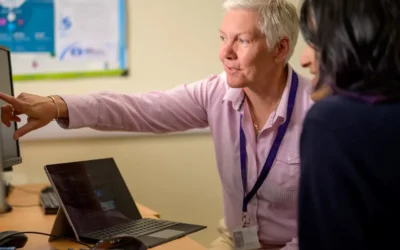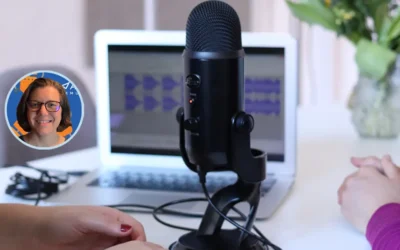A Multimedia Museum CMS Makes a Bigger Picture Possible

Rachael Cristine Woody
That’s a change that may become permanent even after COVID-19 is gone. This miniseries will define what a multimedia CMS is, how it can provide visitors with a bigger picture understanding of the collection, and how it helps us meet ever shifting visitor expectations while assisting museum staff in following user experience best practices.
First, what is a Multimedia Museum CMS?
A multimedia CMS is one that can deliver multiple object types and their resulting digital file type (PDF, JPG, TIF, MP4, MP3) within one item record and within one digital exhibit space.
Item Record Example:
If we’re viewing an item record for a woven basket, at the very least we will see a digital image taken of the basket with the digital file being a TIF or JPG, or sometimes both. In addition to the image, we’ll see the metadata for the object as supplied by the registrar, cataloger, or curator. This is the baseline for most item records you can find in any museum CMS. For CMS platforms that support multimedia, this item record may also contain a digital audio file (MP3) of the basket creator explaining the basket weaving process and how the object would be used within the cultural community from which it originated. Additionally, there may be a PDF transcript of the auditory description, and an MP4 video file of the creator providing the explanation. If all are included in the item record it would include the following multimedia file formats: JPG, TIF, MP3, PDF, and MP4. Some CMS platforms may offer this multimedia set as links that send you outside the record to view or listen to. However, a more evolved CMS will provide the option to experience these additional multimedia files within the item record so that the digital visitor does not have to leave the object and can more fully experience the multiple files for the object within their true context.
Digital Exhibit Example:
If we’re viewing a digital exhibit, we can view multiple item records as a gallery, with each item record containing its own multimedia files. As part of the exhibit experience there may be a video of the curator introducing the exhibit, a playlist of audio files that can be heard while viewing the object they’re related to—and the digital visitor has the option to explore and experience multiple file inputs at once. This serves to provide a fuller and more accurate Cultural Heritage Experience, which we’ll get into in a moment. For most CMS platforms, the exhibit module can handle gathering and presenting multiple item records of differing file types—though some CMS platforms do still struggle with this—however, only the most robust platforms offer a way to group objects together and offer the ability to experience multimedia inputs together.
It’s Critical to Maintain Context in a Digital Space
When objects are displayed as a grouping instead of on their own, additional meaning can be inferred as their relationship serves us additional information beyond just the information contained within the object. As a result, no matter what type of museum you’re in, there’s one principle we can all agree is true: When objects are presented together, they provide additional contextual information—a bigger picture—which increases the amount of information we receive, and can lend more meaning to the collection as a whole. For decades we’ve struggled with the “lost in translation” phenomenon of displaying an object digitally versus in-person. Thanks to the evolution of the CMS as a digital exhibit tool, we can now creatively provide multimedia objects that all lend valuable contextual information that’s only present when objects are displayed in relation to one another.
Deliver Fuller and More Accurate Cultural Heritage Experiences
A fuller and more accurate Cultural Heritage Experience (CHE) is provided when objects are displayed together and in a manner that allows visitors to engage with them in an authentic way. Physical exhibit spaces naturally lend themselves toward facilitating these CHEs, but we’ve struggled to make that transition in an online setting. A large part of that struggle was due to the CMS platform not supporting multiple files and multiple file types at once. Now that some of these technological barriers have been removed, we can and should start crafting CHEs as part of the digital exhibit experience.
Support a More Inclusive Story
A multimedia museum CMS has the capacity to include more content, offer meaningful connections, and deliver a fuller and more accurate CHE. With each of these elements in place the museum staff can share a more inclusive story via the exhibit. There are no space limitations as there would be if we were mounting a physical exhibit, and offering a more authentic and layered story of a community is one critical way the museum staff can further Inclusivity initiatives as part of larger Diversity, Equity, and Inclusion commitments.
Conclusion
Delivering meaningful information, authentic CHEs, and more inclusive stories are all critical features of the work that we do within the museum, and they all work together to serve up an amazing digital engagement experience. The next post in this miniseries will explore how the multimedia museum CMS helps us to better meet digital visitor expectations.

Rachael Cristine Woody
Expert Rachael Cristine Woody advises on museum strategies, collections management, and grant writing for a wide variety of clients. Register here for the next webinar in Rachael’s series on Collections Management System Essentials for Impact on 12/15, where she’ll expand on why the multimedia CMS is the new CMS standard. Learn about Lucidea’s Argus solution for multimedia museum collections management.
Similar Posts
Lucidea Press Releases New Museum CMS Title Demystifying Data Preparation
The latest title from Lucidea Press offers advice from museum expert Rachael Cristine Woody; Demystifying Data Preparation for a New CMS.
Why Senior Leadership by Example is Important for Knowledge Management Success
Getting C-level advocacy for KM is critical for success; senior leaders should provide funding, demonstrate support, and lead by example.
How to Incorporate Interns in Museum CMS Projects: Data Cleanup and Refinement
A museum expert details how interns can be successfully included in museum CMS projects at the data cleanup and refinement stage.
Interview with Susannah Barnes about the SLA Data Community
Susannah Barnes is the Co-Lead of the Data Community for the Special Libraries Association. If you work with data in any capacity, this interview will be of interest to you.
Hosting service
Enjoy all of the benefits of your Lucidea solution with secure, reliable, stress free hosting
Programs & incentives
No matter your size or budget, we’ve got you covered, today and tomorrow



Leave a Comment
Comments are reviewed and must adhere to our comments policy.
0 Comments